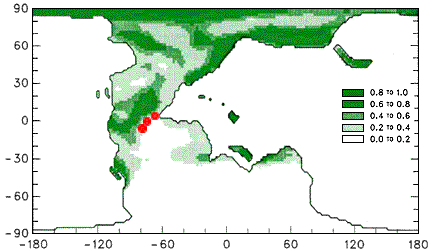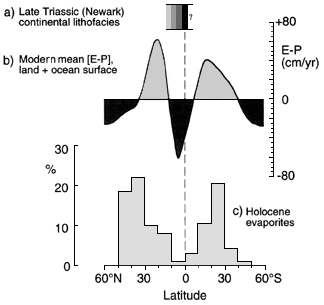3.2.4. Climate Model - Data Discrepancies
P. E. Olsen and D. V. Kent
Global climate models are today a powerful
tool not only for the potential prediction of future climate states under
natural and anthropogenic influences, but are also used to explore the
relationship between various forcing agents in the present and past (e.g.
tectonics, vs. Milankovitch, vs. CO2).
However, the usefulness of any particular climate model is generally tested
by how well its output conforms to a given set of known conditions. As
a bare minimum, climate models are expected to reasonably reproduce present
day conditions, but comparisons to past data, particularly those in which
the boundary conditions are different than today are obviously vital to
testing the model's performance. The importance of this process of climate
model-data comparison is shown in the emphasis placed on "periods of extreme
climate ," in the Earth System History research program, which is a component
of the US Global Change Program at NSF.
An excellent example of the results
of a such a comparison was the large discrepancy between geological and
biological data from the Cretaceous and Eocene and the predictions of older
and present GCMs as pointed out by Barron and colleagues (Barron et al.,
1993; Sloan and Barron, 1992) in their exegesis of "The Equable Climate
Problem". As a direct result of these efforts, focus has shifted from an
emphasis of higher CO2 alone to the role
of other processes that may well be equally important such as ocean heat
transport (e.g. Lyle, 1997; Schmidt and Mysak, 1996).
The Cretaceous and Eocene, however
represent only one end member of Earth system states. They represent "Hot
House" periods with high sea level and dispersed continents. It makes a
useful pair with the present day "Ice House", dispersed-continents-Earth.
An alternative pair of states is seen in the Pangean earth, with a supercontinent.
Pangea that existed under both major climate modes: "Ice House" (Carboniferous
to Early Permian) and "Hot House" (Late Permian to Jurassic).
The Pangean Earth has also received
considerable modeling attention. However, most of this modeling seems to
have resulted in a general consensus that there is agreement between model
and data (e.g. the many papers in the GSA special paper (288) devoted to
Pangea and in the volume arising from the Royal Society of London Discussion
Group Meeting - Allen et al., 1994). Virtually all of the models depict
a "Hot House" Pangea with a dry equatorial zone, except were large mountain
ranges and plateaus are specified (e.g., Fig. 3.2.4.1, below).
| Figure 3.2.4.1 (right): Liquid and soil moisture relative to
saturation in the topmost (to 5 cm) soil layer for July from Wilson's
et al., (1994) GCM for the Carnian (220 Ma). Red dots show position of,
from north to south, 1) the Coal and black shale bearing Deep River, Richmond,
and Dan River basins; 2) the black shale, red bed and evaporite- bearing
Newark, Gettysburg and Culpeper basins; and 3) the evaporite and eolian-bearing
Fundy and Argana basins of Nova Scotia and Morocco.
Note that, not only does the model predict high aridity where there
is coal, but it completely fails to predict the very strong humid to arid
trend from north to south in the rift zone (e.g. Kent and Olsen, 2000).
North also that the tropical humid region shown in the model results lies
nearly exclusively on prescribed high topography. |

GCM results for Pangea (Wilson et al., 1994) |
 |
Recent advances in high-resolution
stratigraphy, paleomagnetics, and paleobiology suggest to us. however,
that there are in fact major first-order discrepancies between Pangean
climate models and reliable data. Perhaps on of the most troubling is cited
agreement between models and data of a desert like equatorial zone (Parrish,
1993; Ziegler et al., 1994; Wilson et al., 1994; Chandler, 1994; Pollard,
1994). In fact, this is in direct conflict with the recent "discovery"
that Late Triassic Pangea had tropical precipitation and evaporation gradients
were not especially different than today's with a distinct wet equatorial
region, even deep within Pangea (e. g. Olsen and Kent, 2000 and Kent and
Olsen, 2000). We suspect, that, much of the apparent agreement may be due
to the ability to choose freely among temporally and geographically relatively
poorly constrained geological data. In addition, despite the observation
that Pangea seemed to pose few barriers to biological dispersal, at least
the Triassic seems to have had biogeographic provinces nearly as distinct
as today. |
| Figure 3.2.4.1 (above): a) Paleolatitudinal
distribution of black shales (black) to aeolian sandstones (light gray)
from the Late Triassic of eastern North America compared to b) nean
zonal variation in [E-P] (evaporation minus precipitation) for the modern
"land + ocean" surface (Crowley and North, 1991) and c) latitudinal
percentage frequency of Holocene evaporite occurences (Gordon, 1975). From
Kent and Olsen (2000). |
|
There are startling differences between
Carboniferous-Early Permian Pangea and Late Triassic-Early Jurassic Pangea
that suggest a smaller role for tectonics and plate position than is usually
assumed by GCM sensitivity tests. To first order, there seems little difference
in the tectonic configuration of latest Paleozoic and early Mesozoic Pangea.
However, the former was in full "Ice House" conditions with major forests
virtually limited to the equatorial region, and the latter was in full
"Hot House" state, with possibly the highest CO2
(10 x present) of the Phanerozoic (see Fig.
2.1: Ekart et al., 1999), and with humid forests not just at the equator
(as previously mentioned, but also spread from the mid-latitudes to the
poles. Equally surprising is the fact that Late Triassic Pangea seem more
similar to the dispersed continent world of the Early Cretaceous than it
does to late Paleozoic Pangea, making us wonder how can relatively minute
changes in Late Cenozoic tectonic configuration could possibly be responsible
for the present Ice House, given the first-order tectonic differences between
Early and Late Mesozoic worlds. In addition, Late Triassic Pangea seems
to been even more equable (and with higher CO2
- Ekart, 1999), than the Early Cretaceous, despite the much lower rated
of oceanic crust formation, posing a strong challenge to the "superplume
hypothesis" for periods of extreme warmth and equability. In fact, the
Late Triassic is the only interval of the Phanerozoic with no evidence
of glacial activity at all (Frakes et al., 1992). All this indicates that
the role of the carbon cycle needs to be looked at very closely in Pangean
climate modes, including possible feedbacks, as has already been concluded
for the Cenozoic and present.
Essential for development and testing
of new models of Pangean climate requires proxy data with appropriate spatial
and temporal scales. Sloan and Morrill (1998) pointed out the continuing
discrepancy between global climate models (with higher pCO2)
and geological and paleontological climate proxy data from times of "extreme
climate", such as the Late Triassic and Early Jurassic. They show that
orbital forcing of climate can play a critical role in continental climate
with extreme values of orbital parameters reducing the interior annual
temperature range by 75%, resulting in cooler summers and warmer winters.
As shown by Sloan and Morrill (1998), these orbital variations must be
taken into account in comparing paleoclimate models to climate proxy records.
While the latter comparison requires the specification of one orbital state,
the geological proxies span many orbital cycles as well as the full range
of orbital forcing. Indeed, it is quite reasonable to expect model-proxy
comparisons to be valid only over intervals of time representing one orbital
state or minimally the climate proxies should be drawn from homologous
portions of several cycles (e.g., times of high insolation). Hence, paleoclimate
proxy data from the geological record must be placed in a temporal framework
appropriate for Milankovitch-scale modeling. While much remains to be done
with outcrops, the workshop panels concluded that very long sections, such
as those available through coring provided the best means of obtaining
the needed high-resolution data for the next generation of models and model-data
comparisons.
REFERENCES:
Allen. J. R. L., Hoskins . B . J., Sellwood. B. W., Spicer, R. A., Valdes,
P. J. (eds.), 1994, Palaeoclimates and their modeling; with special reference
to the Mesozoic era. Chapman & Hall. London, 140 p.
Barron, E.J., W.H. Peterson, D. Pollard, and S. Thompson, 1993, Past
climate and the role of ocean heat transport: model simulations for the
Cretaceous, Paleoceanography 8: 785-798.
Chandler, M. A., 1994, Depiction of modern and Pangean deserts: evaluation
of GCM hydrological diagnostics for paleoclimate studies. GSA Spec. Pap.
288, 117-138
Crowley, T.J., 1993, Geological assessment of the greenhouse effect,
Bulletin of the American Meteorological Society 74: 2363-2373.
Crowley, T.J. and North, G. R., 1991, Paleoclimatology. Oxford Monographs
on Geology and Geophysics 18, 349 p.
Ekart, D. E., Cerling, T. E., Montañez, I. P., and Tabor, N.
J., 1999, A 400 million year carbon isotope record of pedogenic carbonate:
implications for paleoatmopheric carbon dioxide. Amer. Jour. Sci., 299:
805-827.
Frakes-L. A, Francis, E., Syktus, J. I., 1992, Climate modes of the
Phanerozoic; the history of the Earth's climate over the past 600 million
years. Cambridge Univ. Press. Cambridge, United Kingdom. 274 p.
Gordon, W. A., 1975, Distribution by latitude of Phanerozoic evaporite
deposits. Journal of Geology 83: 671-684.
Kent, D. V. and Olsen, P. E., 2000, Magnetic polarity stratigraphy and
paleolatitude of the Triassic--Jurassic Blomidon Formation in the Fundy
basin (Canada): implications for early Mesozoic tropical climate gradients.
Earth And Planetary Science Letters, v. 179, no. 2. p. 311-324.
Lyle, M., 1997: Could early Cenozoic thermohaline circulation have warmed
the poles? Paleoceanography, 12, 161-167.
McIntyre, A. and Molfino, B., 1996, Forcing of Atlantic equatorial and
subpolar millennial cycles by precession. Science 274: 1867-1870.
Pollard, D. and Schulz, M., 1994, A model for the potential locations
of Triassic evaporite basins driven by paleoclimatic GCM simulations. Global
and Planetary Change 9: 233-249.
Short, D. A., Mengel, J. G., Crowley, T. J., Hyde. W. T., and North,
G. R., 1991, Filtering of Milankovitch cycles by Earth's geography. Quaternary
Research (New York).35; 2, Pages 157-173. 1991.
Olsen, P.E. and D.V. Kent, 2000, High resolution early Mesozoic Pangean
climatic transect in lacustrine environments, in Bachmann, G. and Lerche,
I. (eds.), Epicontinental Triassic, Volume 3, Zentralblatt fur Geologie
und Palaontologie, VIII: 1475-1496.
Parrish, J. T., 1993, Climate of the supercontinent Pangea. Journal
of Geology. 101: 215-233.
Sloan, L. C. and E. J. Barron, 1992: Eocene climate model results: Quantitative
comparison to paleoclimatic evidence, Palaeogeog., Palaeoclim., Palaeoecol
., 93: 183-202.
Schmidt, G. and L. Mysak, 1996: Can increased poleward oceanic heat
flux explain the warm Cretaceous climate? Paleoceanography 11: 579-593.
Sloan L.C., and Morrill C., 1998, Orbital forcing and Eocene continental
temperatures. Palaeogeography Palaeoclimatology Palaeoecology, v. 144,
1-2, p. 21-35.
Stocker, T. F., and A. Schmittner,, 1997: Influence of CO2
emission rates on the stability of the thermohaline circulation. Nature,
388, 862-864.
Wilson, K. M., Pollard, D., Hay, W. W., Thompson, S. L., and Wold, C.
N., 1994, General circulation model simulations of Triassic climates: prelimiary
results. GSA Spec. Pap. 288: 91-116.
Ziegler, A. M., Parrish. J. M., Yao, J., Gyllenhaal., E. D., Rowley,
D. B., Parrish, J. T., Nie, S., Bekker, A., Hulver, M. L., 1994, Early
Mesozoic phytogeography and climate. In Allen. J. R. L., Hoskins . B .
J., Sellwood. B. W., Spicer, R. A., Valdes, P. J. (eds.), Palaeoclimates
and their modelling; with special reference to the Mesozoic era. p. 89-97.

